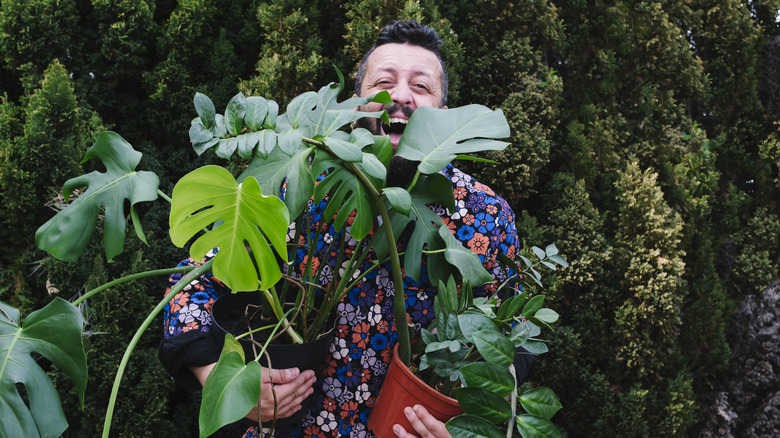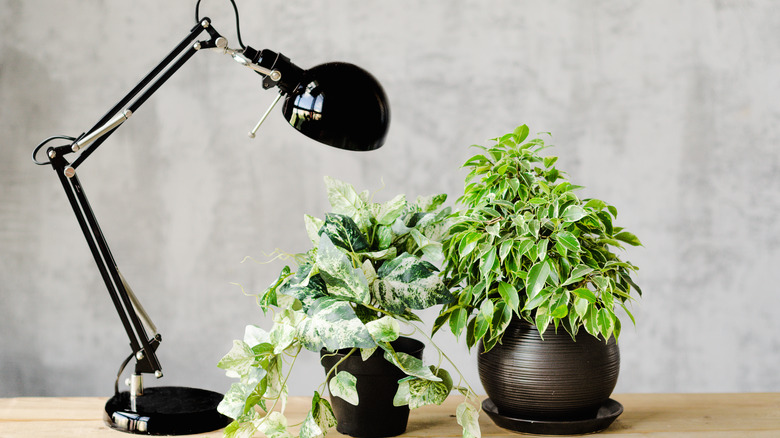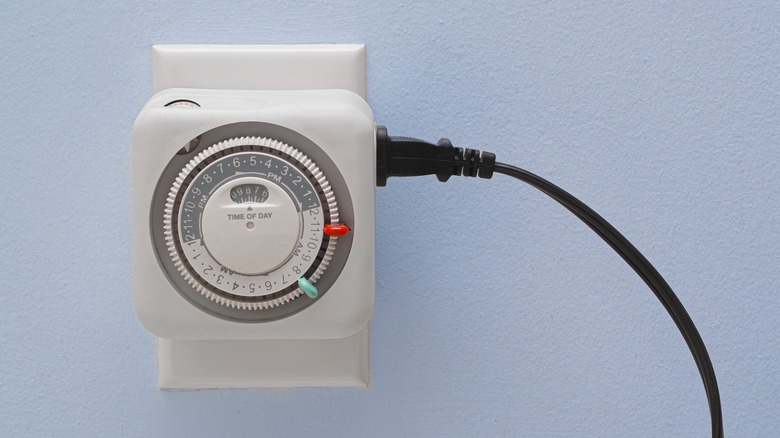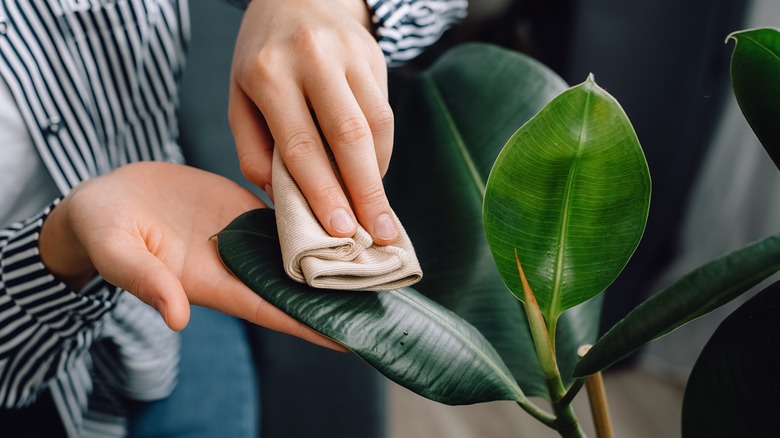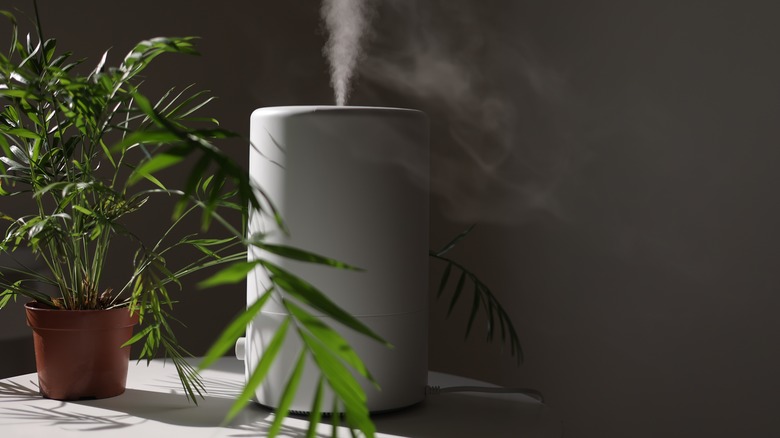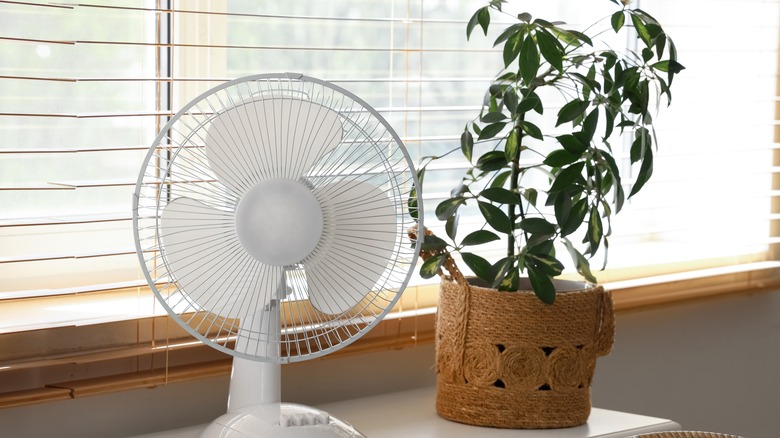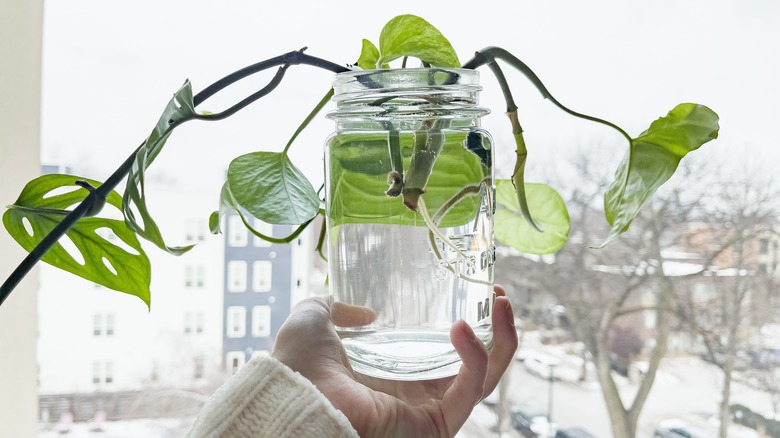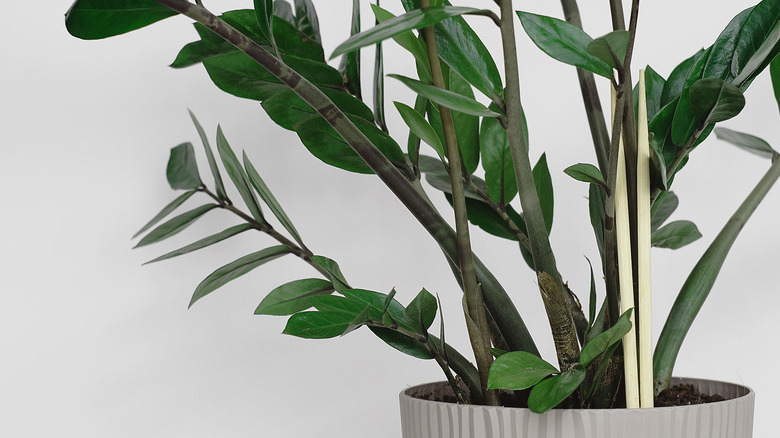11 Unexpected Household Items That Can Help Your Indoor Plants Thrive
We may receive a commission on purchases made from links.
Sometimes it's not enough to just water your houseplants and set them in front of a sunny window. There are times they require a little extra TLC, and that usually means having to buy a new product or two to help solve whatever is ailing them. But before you do that, take a look around your house, because you might be able to repurpose what you already have to achieve the same thing. The idea for this piece came as a sort of Part Two to our "Household ingredients that are good for indoor plants." During the pitch, I admitted to our amazing non-judgemental editors (note: I did write that; it wasn't added by the editors, I swear) that I had over 100 houseplants, so I understood a bit about what it took to save a few bucks here and there for things that would keep houseplants alive. That admission drove me to actually count how many are on my houseplant inventory spreadsheet. Dear readers, I come to you with a current houseplant inventory of 241 plants, so when I say, "There are ways you can find things around your home to help keep your houseplant budget under control," I speak from experience.
But enough of trying to convince you and the slightly concerned House Digest editors that I don't have a hoarding problem and am just "trying to be an expert." Instead, let's discuss the all-too-common things you've probably already got lying around your house that can do double duty at helping your houseplant collection thrive. Plus, I'll leave you with a few tips for tweaking each item just so to ensure it works perfectly at keeping your houseplants happy and healthy, so you can build your hoard to 250 and beyond, should you choose.
Desk lamps can help give plants the light they need to thrive
Let's face it: Getting the right kind of light on your plants is tough. Many common houseplants in the philodendron, monstera, pothos, and syngonium families need some variation of bright but indirect light which sounds simple in theory, but is tricky in practice. Too direct light means scorched leaves, so that rules out bare south or southwest-facing windows. Meanwhile, too little or too indirect light can make your plants either "leggy" because they're reaching for the light or wilted. If you don't have a good supply of west or east-facing windows with some shades, opt for desk lamps and switch out their standard bulbs for grow light bulbs instead.
While any lamp is better than none, lamps with articulating arms that can be positioned directly over plants are ideal. Not only will they provide more concentrated light than a lamp with a drum shade or an exposed Edison-style bulb, but you'll also be able to adjust them as your plants grow. Grow light bulbs used to be hard to get but now come in most standard socket sizes. This 2-pack of Briignite LED Full Spectrum Grow Light A19 bulbs costs nearly the same as regular light bulbs (currently $8.98) and will fit the standard E26 socket found in many U.S. lamps.
Use plug-in timers help automate grow lights
Remembering to turn your grow lamps on and off routinely isn't easy, regardless of whether you have one or multiple. Now, throw in the occasional night out or weekend trip, and suddenly you're stressing out about whether your fun time off meant your houseplants suffer. That's why plug-in timers are so useful. They're like the OGs of automation and have been used for decades to automate lamps, coffee machines, humidifiers, you name it. Just plug your lamp into the timer, set the duration for its on/off cycle, and plug it into any outlet. Now your plant has the exact amount of light it needs daily, and you're left with one less daily chore to deal with.
Plug-in timers can be as simple or fancy as your budget allows. This GE 24-hour mechanical outlet timer has two outlets (there's also a single outlet option) and works just fine, but you can always upgrade to smart timers that link with Alexa, Google Nest, or Apple's Homepod and can adjust to sunrise/sunset changes or your schedule. Whichever option you choose, know that you're making a good choice; plug-in timers go hand-in-hand with desk lamps, ensuring your plants get adequate light without needing to lift a finger.
Magnetic spice racks can hold lots of little plants
If you've got lots of small plants or need to get creative for placing plants somewhere that gets them in the right light, give magnetic spice racks a try. These have become popular add-ons for people turning cabinets with metal backs into indoor greenhouses, like the IKEA Rudusta, but even putting them on the side of your fridge gives you a new place for plants to live. These are an especially great alternative to high shelves for trailing plants like tradescantias, which never seem to get enough light so close to the ceiling.
They're also an excellent way to get plants that need direct sunlight, like cacti and succulents. However, if the side of your refrigerator isn't close to a window or there's no metal backing convenient enough to make these racks work, you can switch to regular floating shelves. Rather than displaying picture frames or knick-knacks, anchor them to a wall near a window and arrange your full-sun-loving plants on them.
Use curtain rods to create a hanging plant wall
Hanging plants and trailing plants are difficult to manage when you don't have a lot of shelf space available. That's why curtain rods are so versatile for houseplant collectors. Not only can you add extra ones to windows and create more spots for plants that need lots of light, but like this TikTok shows, adding them to a blank wall gives you the option to create a plant wall that lets your climbing plants have a structure to brace against. You can also use stick-on cord clips to help train vines or prevent trailing plants' stems from ending up in your face while watching TV.
One thing to keep in mind, though, is light consideration. Don't put the curtain rod too close to the ceiling; you want it low enough so that your plants get the light they need to photosynthesize and ensure there's enough air circulation to prevent mold. If you need to hang it high, though, consider DIYing some charming macrame plant holders or using longer hanging baskets as a way to meet in the middle.
Save microfiber cloths to remove dust from plant leaves
Did you know plants have pores? They're called stomata and are the way a plant takes in carbon dioxide and releases oxygen. This ability to help purify our air is one of the reasons why houseplants are so beneficial for our health. But stomata can get clogged by dust particles, making it difficult for your plant to "breathe." So the next time you get a free promotional microfiber eyeglass cleaning cloth, save it for wiping off the dust from your houseplants. Not only will you clear the stomata, but you'll make it easier for your plants to photosynthesize, too.
Plants with broad leaves like fiddle leaf figs, monsteras, and rubber trees are notorious accumulators of dust, so keep an eye on those and wipe them down at least once a month. Wiping both the topside and underside of the leaves is a good idea because it can help disrupt any potential pest colonies setting up shop on the parts of the leaves you're less likely to notice. If you'd like to make this chore even easier, invest in a pair of microfiber gloves and press each leaf through your slightly-clasped, gloved hands. You may find you'll have more control and can run through your dusting chores faster, too.
Or use a cosmetic brush for deep groves and hairy stems
Microfiber cloths and gloves work well for most plants, but not all. Hairy plants, like African violets, or plants with deep grooves in their leaves, like the alocasia in this TikTok, need a little extra help. That's where cosmetic brushes or fine paintbrushes come into play.
Use brushes with soft bristles to ensure you don't damage the plant's tissues. Avoid using brushes that are wet or dusting when you've just watered the plants, as it's hard to remove wet dust clumps from the soft hairs on plant stems. And to be safe, it's probably best to keep your makeup or painting brushes separate from your plant dusting brushes to avoid cross-contamination.
Room humidifiers keep tropical houseplants happy
Many houseplants are some variation of a plant that's native to a tropical region. Consequently, your houseplant most likely loves setups that replicate its jungle or rainforest origins: dappled light, soil full of organic materials that came from decaying matter, and humid air that's trapped under the forest canopy. The dappled light and soil we're able to replicate easily enough, but it's hard to make things naturally humid in many spots in a home besides the bathroom. That's why room humidifiers are so helpful for plant parents, especially during the winter when humidity levels can drop as low as 10%. Most tropical houseplants need anywhere from 40% to 60% humidity to thrive, so imagine what a 10% humidity situation can cause them. If you start to notice your plants getting brown tips or edges around their leaves, dried flower buds, or low growth during a time when they should be growing (spring and summer, usually), then it might be time to kick on the humidifier.
Humidifiers, like plug-in timers, come in a range of features and prices, so you shouldn't have a problem finding one that fits your budget. Look for one that's easy to clean, as you'll want to remove the leftover buildup that tap or well water leaves in the tank over time. You'll also want one that gives your plants a regular misting. Depending on your budget, you can get one with a built-in timer or opt for one that's a little cheaper and has no timer and pair it with a plug-in outlet timer instead.
Use fans to circulate air around plants and reduce mold
Whether you're keeping your plants out in the open with a room humidifier or are going the indoor greenhouse cabinet route, a big concern you'll need to deal with is what to do about moisture. Even if you don't give your plants additional humidity, simply grouping plants together can raise the humidity around them, so dealing with extra moisture is unavoidable. So, what's the problem with moisture? It brings mold and fungal issues, leading to mold in your soil, which is harmless but ugly, and root rot, which is harmful and ugly, too.
To prevent this, you need to have good air circulation around your plants, so add a fan. If you're keeping your plants in a greenhouse cabinet, USB fans work great since they're small, and their thin cords can fit through tiny gaps between doors. If your plants are in a room, any type of fan, including a ceiling fan, will be fine. Use a low setting so that you don't disrupt the plants too much, and run it only when the humidifier is off so that you don't accidentally blow the mist away from your plants.
Mason jars are the perfect houseplant companion
Mason jars are one of the best friends a houseplant parent could ever have. Mason jars can help you double your houseplant collection thanks to water propagation (which is how some of us have accumulated a collection of more than 200 plants), and there are even some indoor plants that can live in mason jars without drainage if you do it right. They're cheap and available pretty much everywhere, from your local thrift store and flea market to every giant craft store chain and discount home goods shop. They come in a plethora of colors and sizes, and are just so versatile that it's totally acceptable to have a stash on hand at all times.
If you want to use them for houseplants or plant cuttings, here are a few tips. Clear jars are usually recommended for water propagation since they allow the most light to reach the cutting's submerged end, promoting root growth. However, if you're not careful, you can get an algae outbreak, so change your water regularly. Secondly, use jars that are a good size for your plant or cutting. Remember, leaves will rot if submerged in water, so cuttings need the leafy parts to stay above the water line, and a jar that's too big could make it hard to manage. Plants that live in jars with soil need their moisture levels carefully monitored, and jars that are too big could cause water issues.
Use chopsticks to prop up tall or climbing plants
Some houseplants are victims of their own success. The bigger they get, the harder it is for the stems to support itself and the plant ends up drooping. Monsteras are famous for this problem, but ZZ plants, pothos, and philodendrons are just as guilty. For bigger plants, there are options like trellises, stakes, or building moss poles to help them thrive, but what about the little guys who aren't at that level yet? For young plants, try staking them with chopsticks.
Chopsticks are fantastic support stakes for starter plants because they're sturdy, simple, and super easy to find. While any clean, unused chopstick will do (please don't introduce sugars or food crumbs into your soil), look for ones that have a lacquer or resin coating over them. This will help reduce the chances of them rotting in the soil over time. To use them as a plant stake, you can either drive one into the soil and then secure the plant's stalk with a piece of string, baker's twine, or plant hook and loop tape. Secure the stalk with your chosen tie so it's tight but not so restrictive that it cuts off circulation. Another option is to use two chopsticks like the image above and drive them into the soil in a slight V shape. This works better for bushier plants with fewer individual stalks that need bracing.
Plastic zipper bags make excellent mini greenhouses
Let's say you only have one or two beloved houseplants that are in desperate need of humidity. But you can't get a room humidifier, and grouping them together isn't giving them enough moisture to make them happy. What can you do? Put them in a plastic bag. Plastic bags work like a mini greenhouse or cloche and trap moisture that's in the soil, giving your plant the humidity it needs. Not only is this great for tall plants that can't fit in a terrarium, but it's also a fantastic option for ensuring your plants get the humidity they need while you're on vacation.
Plastic bags with a zipper or snap lock seal work best as they trap humidity and retain moisture. Use a bag that's big enough so that none of it is touching the plant, and keep your makeshift greenhouse out of direct light to prevent the inside temperature from getting too hot. Your plant can live safely inside its bag for about a week or so before it needs a breath of fresh air and a drink of water. While it might not be the most aesthetically pleasing option, plastic bags are a perfect makeshift solution to ensure your plant, especially one suffering from a lack of humidity, gets the moisture it needs.
